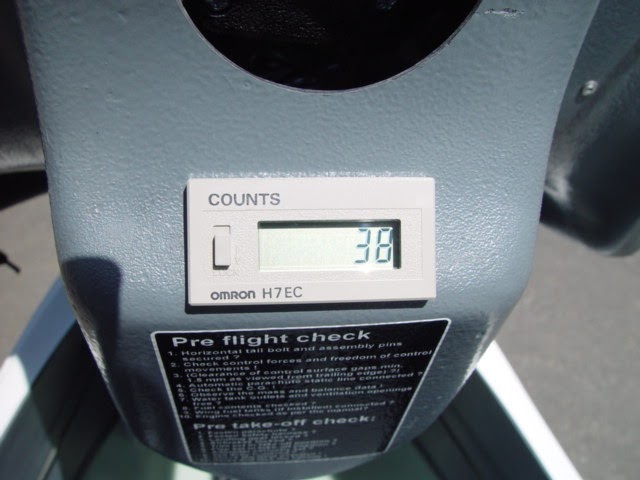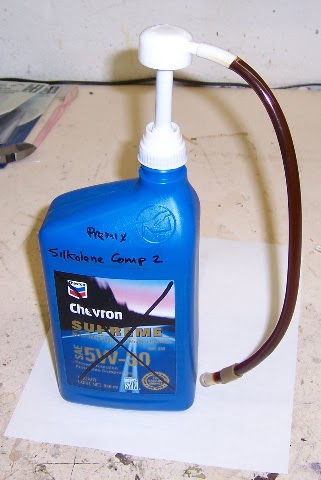Basic oil system data
Oil consumption rate:
-
- 0.5 ml/1000 revolutions (REVOLUTIONS, not RPM)
Oil tank capacity:
-
- ~700 ml (conversation with the factory, Oct 2011)
Oil remaining when the Ilec oil warning light illuminates:
-
- "less than 132 ml" (flight manual)
- "only a reserve for about 10 minutes of engine operation" (flight manual)
Based on the above numbers, we can calculate the engine can be operated at max RPM (6900 RPM) for about 2 hours, 45 minutes before the oil level in the oil tank is too low (don't count on it if you haven't tested YOUR glider!). This is true, whether climbing at full throttle and 6900 RPM, or cruising at part throttle and 6900 RPM, because the oil consumption is independent of the amount of fuel used.
This "power independent" oil consumption has important consequences if you have the wing fuel tanks (bags) installed:
- Consequence #1: that duration is enough to use all the fuel in the fuselage tank and two wing tanks only if you use the "sawtooth" method the entire time, which uses full engine power.
- Consequence #2: if you cruise (level flight, 6900 rpm, ~70-75 knots, about half throttle), you will run out of oil before you run out of fuel when using the fuselage and two wing tanks.
Measuring the oil consumption
What's wrong with the manual's method?
The manual gives an approximate oil consumption for each liter of fuel. This number seems close to what people measure if they use the engine only for the launch. These are pilots that push or tow their gliders to the takeoff point instead of taxiing. Low rpm engine use apparently uses fuel at a different liters/revolution than full power, so pilots that taxi get very variable, essentially worthless, measurements indicating not enough oil is being used.
Why use a revolution counter?
The oil pump on our engine is a "positive displacement" type, meaning the amount of oil pumped is directly proportional to the number of revolutions. In other words, 10 revolutions pumps 10 times as much oil as one revolution.
Our pump is driven directly from the engine, so the amount of oil pumped is directly related to the number of engine revolutions. The factor is 0.5 ml per 1000 revolutions; e.g., running the engine at 3500 rpm for 2 minutes (7000 revolutions) should pump 3.5 ml of oil. By comparing the revolutions mearsured with the counter to the amount of oil actually removed from the oil tank, we can determine if the engine is consuming the correct amount of oil. Too much oil consumed may indicate a leak in the oil tank, or in it's oil line and it's connections to the pump; too little oil consumed may indicate the pump is not working properly, or has a blocked oil line going to the engine.
The factory does provide a method for measuring the oil consumption in a maintenance Instruction ("Oil Consumption" Issue 1) available on the Schleicher website. Basically, you run the engine at a constant rpm for several minutes, then measure the amount of oil removed from the oil tank.
Installing a "Oil Consumption meter"
[Nov 2008 - bumper]
I installed Eric's rev (revolution) counter on my ship. The counter is from Digi-Key (part number Z865), and is an Omron H7EC-NV-B. [see below for background on why a revolution counter is used]

If you choose to mount the counter in this location, I suggest favoring the bottom edge as shown. The hole was laid out with a fine tip marker and then cut out with a Dremel tool using a 1/8" carbide burr - - carefully! Corners were squared up with a file. The face plate lip of the counter is not all that wide, so the hole can't be much oversize.
With power off, I removed plug on the rear of the ILEC. If you haven't done this before, there's a small spring latch on each side of the DB29 plug, one pushes up and the other pushed down to release. Then I stripped back the heat shrink cable sheath for several inches to make it easier to splice in the two wires needed for the counter (signal and ground).
To save you the trouble of taking apart the plug to check colors and pins (g) - - there are no duplicate colors used in the wiring harness. The signal wire is a smaller solid black wire (pin 21) and ground is a larger diameter solid blue wire (pin 15). Strip a short length of insulation from each, offsetting so the splices will not be adjacent to each other. Then solder wires to each and insulate with tape, I used self-vulcanizing rubber tape. Wire splice to small black wire goes to terminal #1 on the counter, wire spliced to the blue wire (ground) will go to terminal #2 of the counter.
Eric suggested it would also be an option to mount the counter on the seat pan in a convenient spot and splice into the cable as it goes through that area. I think the under panel location is pretty good though, with just one warning! If you use the "wallet trick" to remove and replace your canopy (that's where you put a wallet on the lower console and close the canopy on it to make it easier to remove) be careful to keep the wallet away from the forward edge of the lower console top as the counter will hit the wallet. No need to ask me how I know this, but at least I didn't force the issue and break anything.
Again, using Eric suggestion, I cut off most of the end of a 60 ml irrigation syringe. Then overfilled the oil tank and pushed the nose of the modified syringe as far as possible into the tank to suck out as much as possible to get the oil to the correct "calibrated" full level. After running the engine, it should be a simple matter to add a measured amount of oil with the syringe to overfill the tank, then remove as much as possible with the short nose syringe and subtract the amount of removed oil from the previous added amount to determine oil used.
Per Eric, the engine should use about 0.5 ml of oil per 1000 revolutions, so 70,000 total count should see 35 ml of oil used.
Another filling method

- I use an oil pump that attaches to a one quart (~ 1 liter) plastic oil bottle. The pump was purchased at an auto parts store. The plastic hose came with the pump, and is needed to direct the oil into the tank. The bottle sits on the muffler while I'm pumping the oil. The end of the hose has a piece of rubber tubing slid over it, leaving about 3/4" (20 mm) of the plastic tube before the rubber tube begins. To measure the amount of oil added:Note amount of oil in the bottle (there is a scale on the side)
- Put the hose into the tank until the bottom end of the rubber tubing contacts the top of the tank opening
- Pump oil into the tank until the oil just touches the end of the plastic tubing.
- Note the amount of oil left in the bottle
- Subtract that from the beginning amount, and you have the amount added.